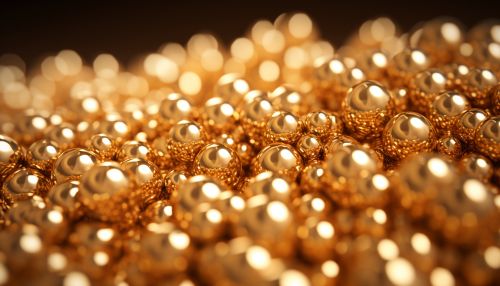Gold Nanoparticles
Introduction
Gold nanoparticles, also known as colloidal gold, are sub-micrometer-sized particles of gold that have been used in various fields such as electronics, medicine, and materials science due to their unique optical, electronic, and molecular-recognition properties. These nanoparticles exhibit a variety of shapes and sizes, including spheres, rods, and shells, which can be manipulated to achieve desired properties.


Synthesis
The synthesis of gold nanoparticles involves the reduction of gold ions by various reducing agents. The most common method is the Turkevich method, which involves the reduction of gold ions by citrate ions. This method produces spherical gold nanoparticles with a narrow size distribution. Other methods include the Brust-Schiffrin method, which produces thiol-protected gold nanoparticles, and the seed-mediated growth method, which allows for the synthesis of gold nanoparticles of various shapes.
Properties
Gold nanoparticles have unique properties that are not seen in bulk gold. These include surface plasmon resonance, which is the collective oscillation of electrons in response to light. This property gives gold nanoparticles their distinctive colors, which can range from red to purple depending on their size and shape. Gold nanoparticles also exhibit high electrical conductivity, chemical stability, and biocompatibility, making them suitable for various applications.
Applications
Medicine
In medicine, gold nanoparticles are used in drug delivery, cancer therapy, and bioimaging. Due to their small size and biocompatibility, they can be used to deliver drugs to specific cells or tissues in the body. They can also be used in cancer therapy, where they are used to deliver cancer-killing agents directly to tumor cells. In bioimaging, gold nanoparticles are used as contrast agents to enhance the visibility of cells or tissues.
Electronics
In electronics, gold nanoparticles are used in the fabrication of nanoscale devices and sensors. Due to their high electrical conductivity and chemical stability, they can be used to create conductive paths in nanoscale devices. They can also be used in sensors, where they can detect the presence of specific molecules or ions.
Materials Science
In materials science, gold nanoparticles are used in the creation of nanocomposites and catalysts. They can be incorporated into various materials to enhance their properties, such as strength, conductivity, and chemical resistance. They can also be used as catalysts, where they can speed up chemical reactions.
Challenges and Future Directions
Despite their potential, the use of gold nanoparticles is not without challenges. These include the control of their size and shape, their stability, and their potential toxicity. Future research will need to address these challenges in order to fully realize the potential of gold nanoparticles.
